Reflective Essay on Safe Handling and Disposal of Sharps in Clinical Practice
VerifiedAdded on 2023/06/08
|8
|2092
|354
AI Summary
This reflective essay discusses an incident that occurred during a clinical placement related to the safe handling and disposal of sharps. It analyzes the incident using the Driscoll’s model of reflection and provides a rationale for the incident. The essay also suggests steps that can be taken in future to prevent such incidents. The essay highlights the importance of following competency standards and guidelines for an effective and safe delivery of healthcare services.
Contribute Materials
Your contribution can guide someone’s learning journey. Share your
documents today.
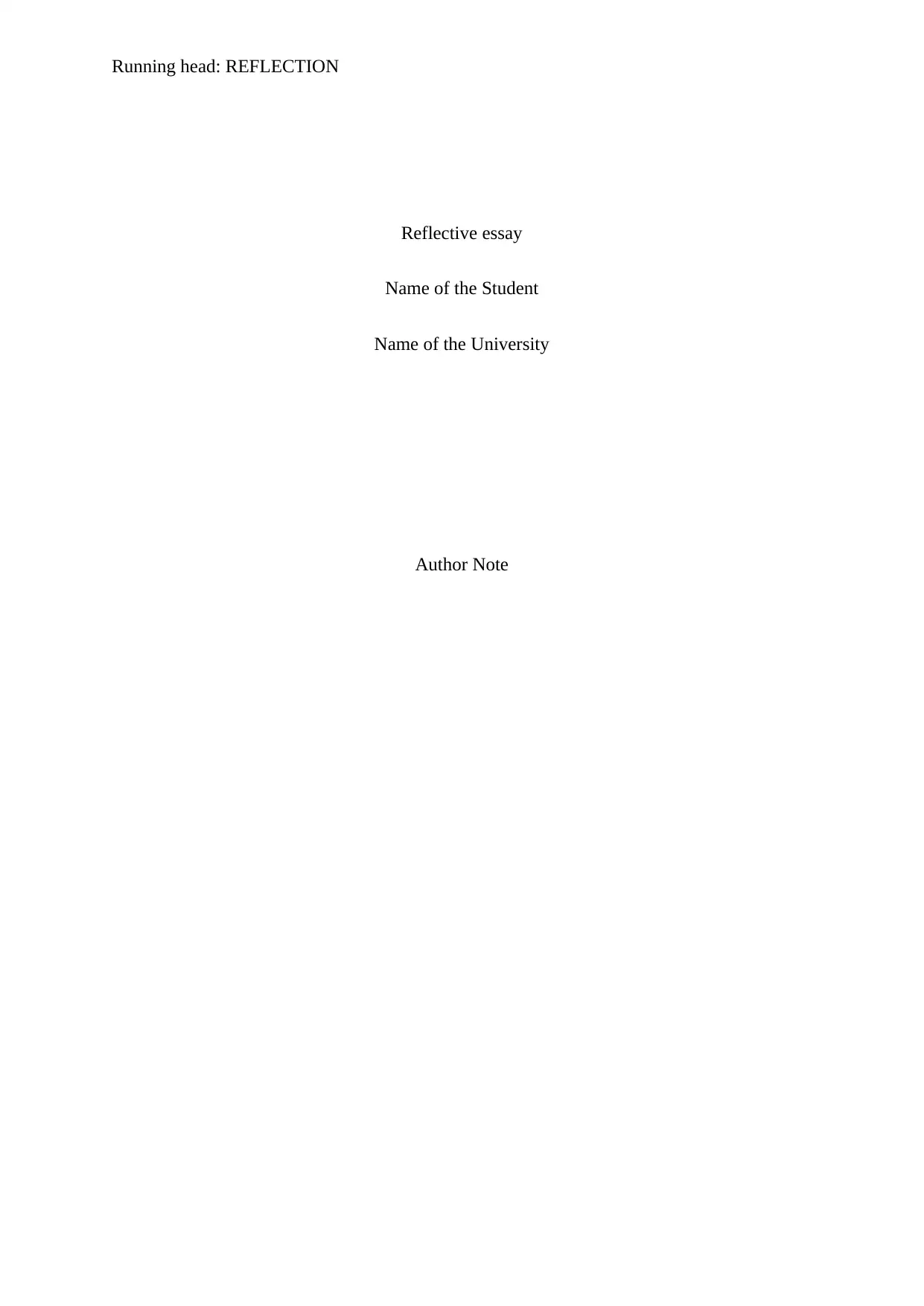
Running head: REFLECTION
Reflective essay
Name of the Student
Name of the University
Author Note
Reflective essay
Name of the Student
Name of the University
Author Note
Secure Best Marks with AI Grader
Need help grading? Try our AI Grader for instant feedback on your assignments.
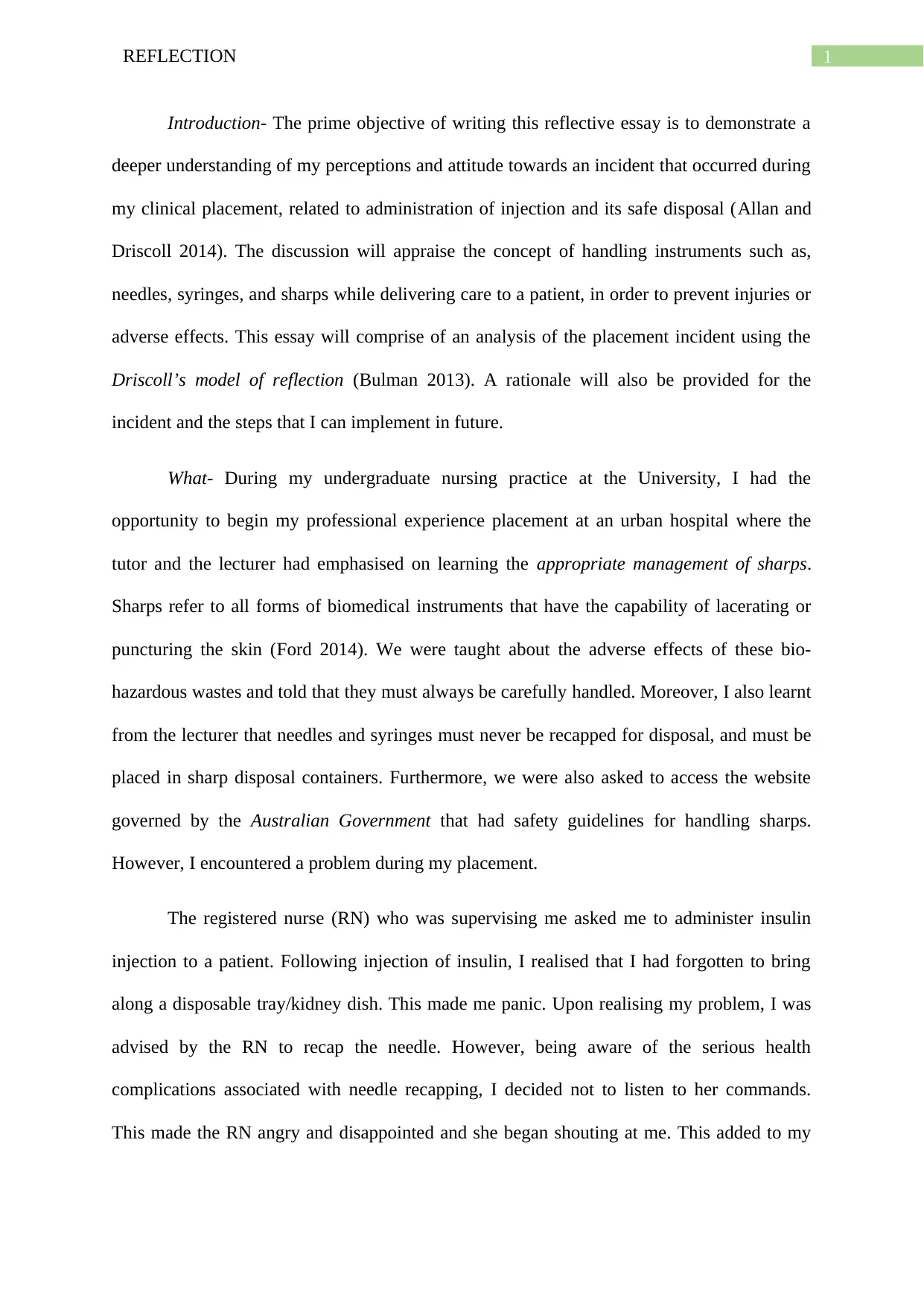
1REFLECTION
Introduction- The prime objective of writing this reflective essay is to demonstrate a
deeper understanding of my perceptions and attitude towards an incident that occurred during
my clinical placement, related to administration of injection and its safe disposal (Allan and
Driscoll 2014). The discussion will appraise the concept of handling instruments such as,
needles, syringes, and sharps while delivering care to a patient, in order to prevent injuries or
adverse effects. This essay will comprise of an analysis of the placement incident using the
Driscoll’s model of reflection (Bulman 2013). A rationale will also be provided for the
incident and the steps that I can implement in future.
What- During my undergraduate nursing practice at the University, I had the
opportunity to begin my professional experience placement at an urban hospital where the
tutor and the lecturer had emphasised on learning the appropriate management of sharps.
Sharps refer to all forms of biomedical instruments that have the capability of lacerating or
puncturing the skin (Ford 2014). We were taught about the adverse effects of these bio-
hazardous wastes and told that they must always be carefully handled. Moreover, I also learnt
from the lecturer that needles and syringes must never be recapped for disposal, and must be
placed in sharp disposal containers. Furthermore, we were also asked to access the website
governed by the Australian Government that had safety guidelines for handling sharps.
However, I encountered a problem during my placement.
The registered nurse (RN) who was supervising me asked me to administer insulin
injection to a patient. Following injection of insulin, I realised that I had forgotten to bring
along a disposable tray/kidney dish. This made me panic. Upon realising my problem, I was
advised by the RN to recap the needle. However, being aware of the serious health
complications associated with needle recapping, I decided not to listen to her commands.
This made the RN angry and disappointed and she began shouting at me. This added to my
Introduction- The prime objective of writing this reflective essay is to demonstrate a
deeper understanding of my perceptions and attitude towards an incident that occurred during
my clinical placement, related to administration of injection and its safe disposal (Allan and
Driscoll 2014). The discussion will appraise the concept of handling instruments such as,
needles, syringes, and sharps while delivering care to a patient, in order to prevent injuries or
adverse effects. This essay will comprise of an analysis of the placement incident using the
Driscoll’s model of reflection (Bulman 2013). A rationale will also be provided for the
incident and the steps that I can implement in future.
What- During my undergraduate nursing practice at the University, I had the
opportunity to begin my professional experience placement at an urban hospital where the
tutor and the lecturer had emphasised on learning the appropriate management of sharps.
Sharps refer to all forms of biomedical instruments that have the capability of lacerating or
puncturing the skin (Ford 2014). We were taught about the adverse effects of these bio-
hazardous wastes and told that they must always be carefully handled. Moreover, I also learnt
from the lecturer that needles and syringes must never be recapped for disposal, and must be
placed in sharp disposal containers. Furthermore, we were also asked to access the website
governed by the Australian Government that had safety guidelines for handling sharps.
However, I encountered a problem during my placement.
The registered nurse (RN) who was supervising me asked me to administer insulin
injection to a patient. Following injection of insulin, I realised that I had forgotten to bring
along a disposable tray/kidney dish. This made me panic. Upon realising my problem, I was
advised by the RN to recap the needle. However, being aware of the serious health
complications associated with needle recapping, I decided not to listen to her commands.
This made the RN angry and disappointed and she began shouting at me. This added to my
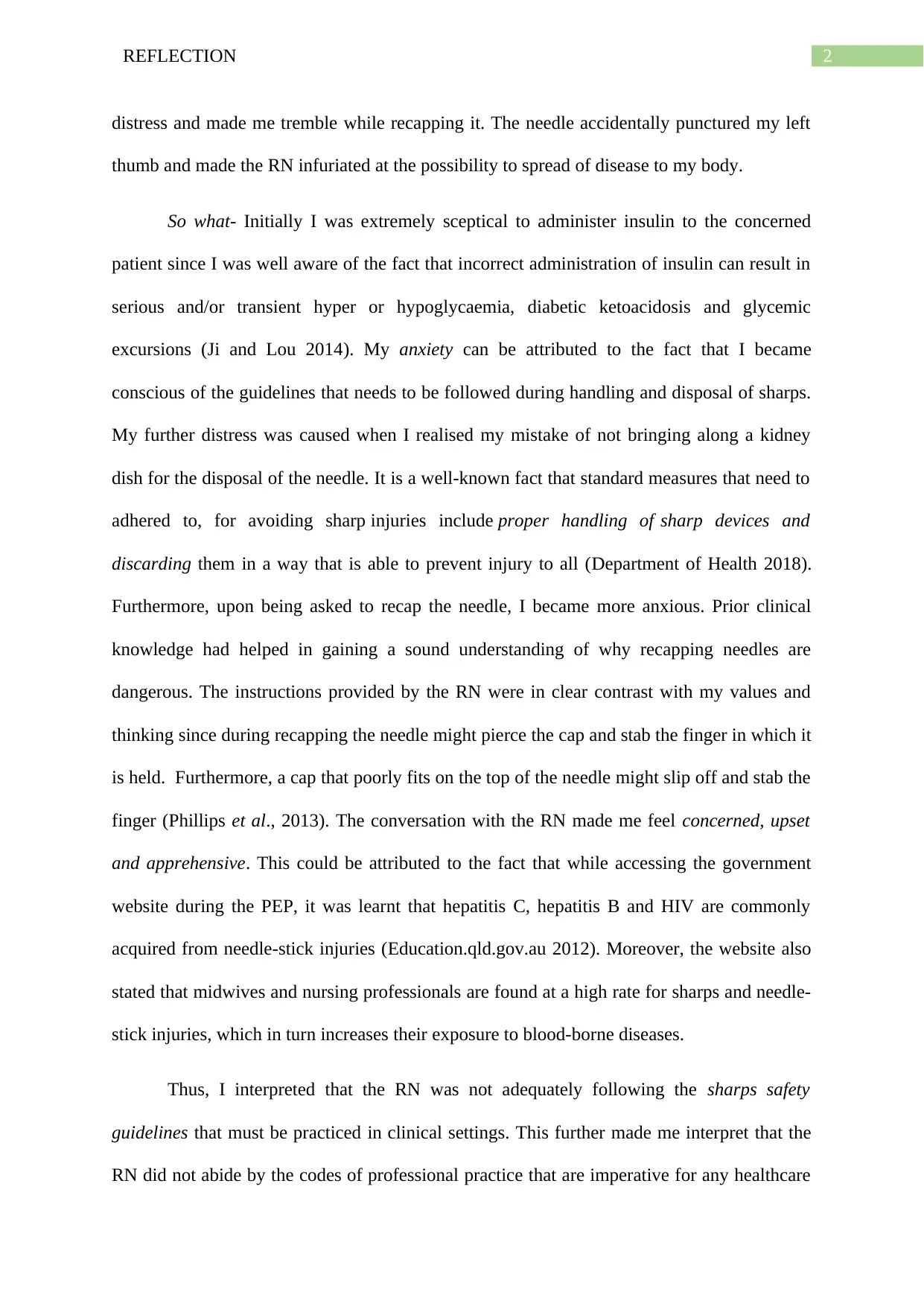
2REFLECTION
distress and made me tremble while recapping it. The needle accidentally punctured my left
thumb and made the RN infuriated at the possibility to spread of disease to my body.
So what- Initially I was extremely sceptical to administer insulin to the concerned
patient since I was well aware of the fact that incorrect administration of insulin can result in
serious and/or transient hyper or hypoglycaemia, diabetic ketoacidosis and glycemic
excursions (Ji and Lou 2014). My anxiety can be attributed to the fact that I became
conscious of the guidelines that needs to be followed during handling and disposal of sharps.
My further distress was caused when I realised my mistake of not bringing along a kidney
dish for the disposal of the needle. It is a well-known fact that standard measures that need to
adhered to, for avoiding sharp injuries include proper handling of sharp devices and
discarding them in a way that is able to prevent injury to all (Department of Health 2018).
Furthermore, upon being asked to recap the needle, I became more anxious. Prior clinical
knowledge had helped in gaining a sound understanding of why recapping needles are
dangerous. The instructions provided by the RN were in clear contrast with my values and
thinking since during recapping the needle might pierce the cap and stab the finger in which it
is held. Furthermore, a cap that poorly fits on the top of the needle might slip off and stab the
finger (Phillips et al., 2013). The conversation with the RN made me feel concerned, upset
and apprehensive. This could be attributed to the fact that while accessing the government
website during the PEP, it was learnt that hepatitis C, hepatitis B and HIV are commonly
acquired from needle-stick injuries (Education.qld.gov.au 2012). Moreover, the website also
stated that midwives and nursing professionals are found at a high rate for sharps and needle-
stick injuries, which in turn increases their exposure to blood-borne diseases.
Thus, I interpreted that the RN was not adequately following the sharps safety
guidelines that must be practiced in clinical settings. This further made me interpret that the
RN did not abide by the codes of professional practice that are imperative for any healthcare
distress and made me tremble while recapping it. The needle accidentally punctured my left
thumb and made the RN infuriated at the possibility to spread of disease to my body.
So what- Initially I was extremely sceptical to administer insulin to the concerned
patient since I was well aware of the fact that incorrect administration of insulin can result in
serious and/or transient hyper or hypoglycaemia, diabetic ketoacidosis and glycemic
excursions (Ji and Lou 2014). My anxiety can be attributed to the fact that I became
conscious of the guidelines that needs to be followed during handling and disposal of sharps.
My further distress was caused when I realised my mistake of not bringing along a kidney
dish for the disposal of the needle. It is a well-known fact that standard measures that need to
adhered to, for avoiding sharp injuries include proper handling of sharp devices and
discarding them in a way that is able to prevent injury to all (Department of Health 2018).
Furthermore, upon being asked to recap the needle, I became more anxious. Prior clinical
knowledge had helped in gaining a sound understanding of why recapping needles are
dangerous. The instructions provided by the RN were in clear contrast with my values and
thinking since during recapping the needle might pierce the cap and stab the finger in which it
is held. Furthermore, a cap that poorly fits on the top of the needle might slip off and stab the
finger (Phillips et al., 2013). The conversation with the RN made me feel concerned, upset
and apprehensive. This could be attributed to the fact that while accessing the government
website during the PEP, it was learnt that hepatitis C, hepatitis B and HIV are commonly
acquired from needle-stick injuries (Education.qld.gov.au 2012). Moreover, the website also
stated that midwives and nursing professionals are found at a high rate for sharps and needle-
stick injuries, which in turn increases their exposure to blood-borne diseases.
Thus, I interpreted that the RN was not adequately following the sharps safety
guidelines that must be practiced in clinical settings. This further made me interpret that the
RN did not abide by the codes of professional practice that are imperative for any healthcare
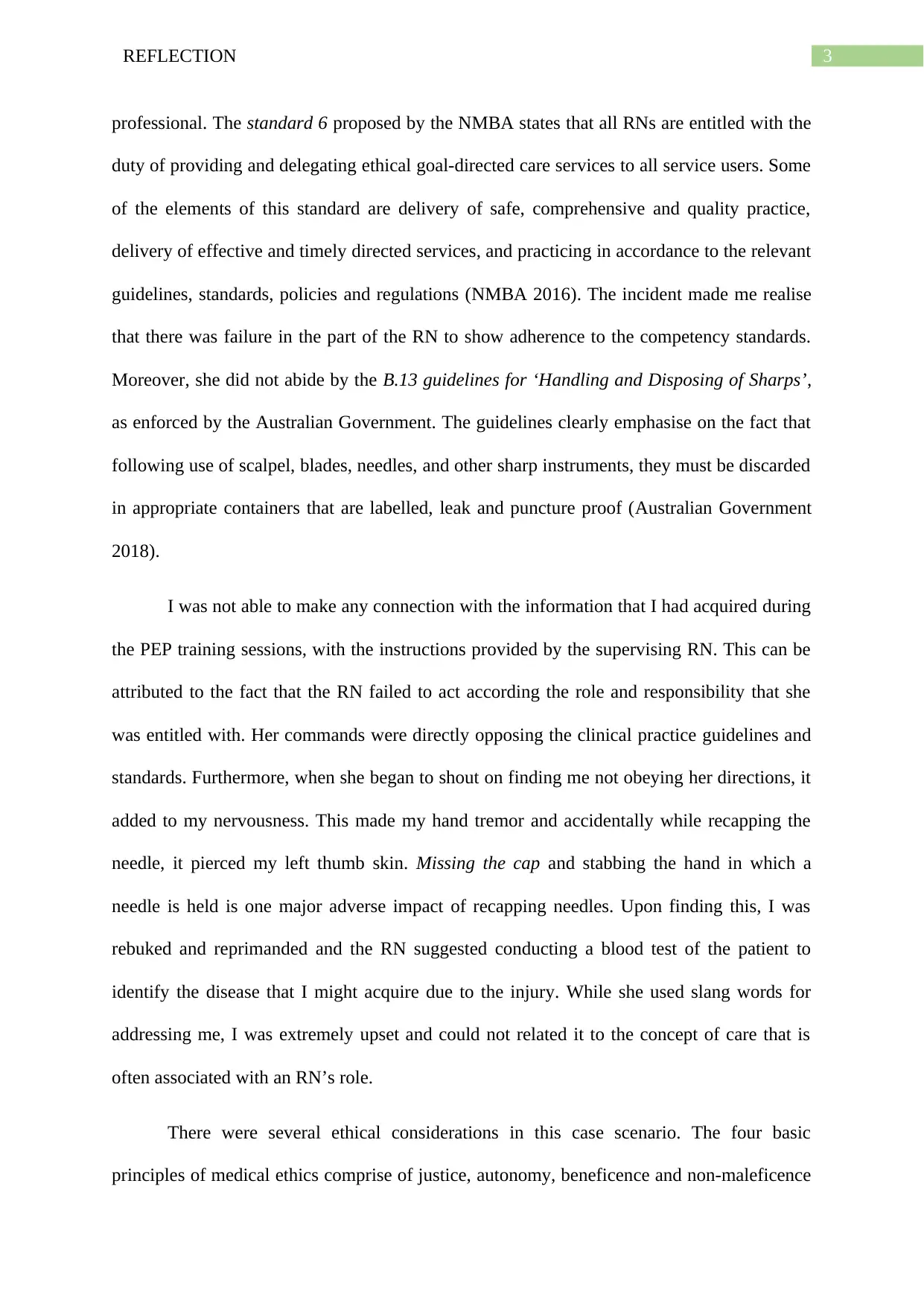
3REFLECTION
professional. The standard 6 proposed by the NMBA states that all RNs are entitled with the
duty of providing and delegating ethical goal-directed care services to all service users. Some
of the elements of this standard are delivery of safe, comprehensive and quality practice,
delivery of effective and timely directed services, and practicing in accordance to the relevant
guidelines, standards, policies and regulations (NMBA 2016). The incident made me realise
that there was failure in the part of the RN to show adherence to the competency standards.
Moreover, she did not abide by the B.13 guidelines for ‘Handling and Disposing of Sharps’,
as enforced by the Australian Government. The guidelines clearly emphasise on the fact that
following use of scalpel, blades, needles, and other sharp instruments, they must be discarded
in appropriate containers that are labelled, leak and puncture proof (Australian Government
2018).
I was not able to make any connection with the information that I had acquired during
the PEP training sessions, with the instructions provided by the supervising RN. This can be
attributed to the fact that the RN failed to act according the role and responsibility that she
was entitled with. Her commands were directly opposing the clinical practice guidelines and
standards. Furthermore, when she began to shout on finding me not obeying her directions, it
added to my nervousness. This made my hand tremor and accidentally while recapping the
needle, it pierced my left thumb skin. Missing the cap and stabbing the hand in which a
needle is held is one major adverse impact of recapping needles. Upon finding this, I was
rebuked and reprimanded and the RN suggested conducting a blood test of the patient to
identify the disease that I might acquire due to the injury. While she used slang words for
addressing me, I was extremely upset and could not related it to the concept of care that is
often associated with an RN’s role.
There were several ethical considerations in this case scenario. The four basic
principles of medical ethics comprise of justice, autonomy, beneficence and non-maleficence
professional. The standard 6 proposed by the NMBA states that all RNs are entitled with the
duty of providing and delegating ethical goal-directed care services to all service users. Some
of the elements of this standard are delivery of safe, comprehensive and quality practice,
delivery of effective and timely directed services, and practicing in accordance to the relevant
guidelines, standards, policies and regulations (NMBA 2016). The incident made me realise
that there was failure in the part of the RN to show adherence to the competency standards.
Moreover, she did not abide by the B.13 guidelines for ‘Handling and Disposing of Sharps’,
as enforced by the Australian Government. The guidelines clearly emphasise on the fact that
following use of scalpel, blades, needles, and other sharp instruments, they must be discarded
in appropriate containers that are labelled, leak and puncture proof (Australian Government
2018).
I was not able to make any connection with the information that I had acquired during
the PEP training sessions, with the instructions provided by the supervising RN. This can be
attributed to the fact that the RN failed to act according the role and responsibility that she
was entitled with. Her commands were directly opposing the clinical practice guidelines and
standards. Furthermore, when she began to shout on finding me not obeying her directions, it
added to my nervousness. This made my hand tremor and accidentally while recapping the
needle, it pierced my left thumb skin. Missing the cap and stabbing the hand in which a
needle is held is one major adverse impact of recapping needles. Upon finding this, I was
rebuked and reprimanded and the RN suggested conducting a blood test of the patient to
identify the disease that I might acquire due to the injury. While she used slang words for
addressing me, I was extremely upset and could not related it to the concept of care that is
often associated with an RN’s role.
There were several ethical considerations in this case scenario. The four basic
principles of medical ethics comprise of justice, autonomy, beneficence and non-maleficence
Secure Best Marks with AI Grader
Need help grading? Try our AI Grader for instant feedback on your assignments.
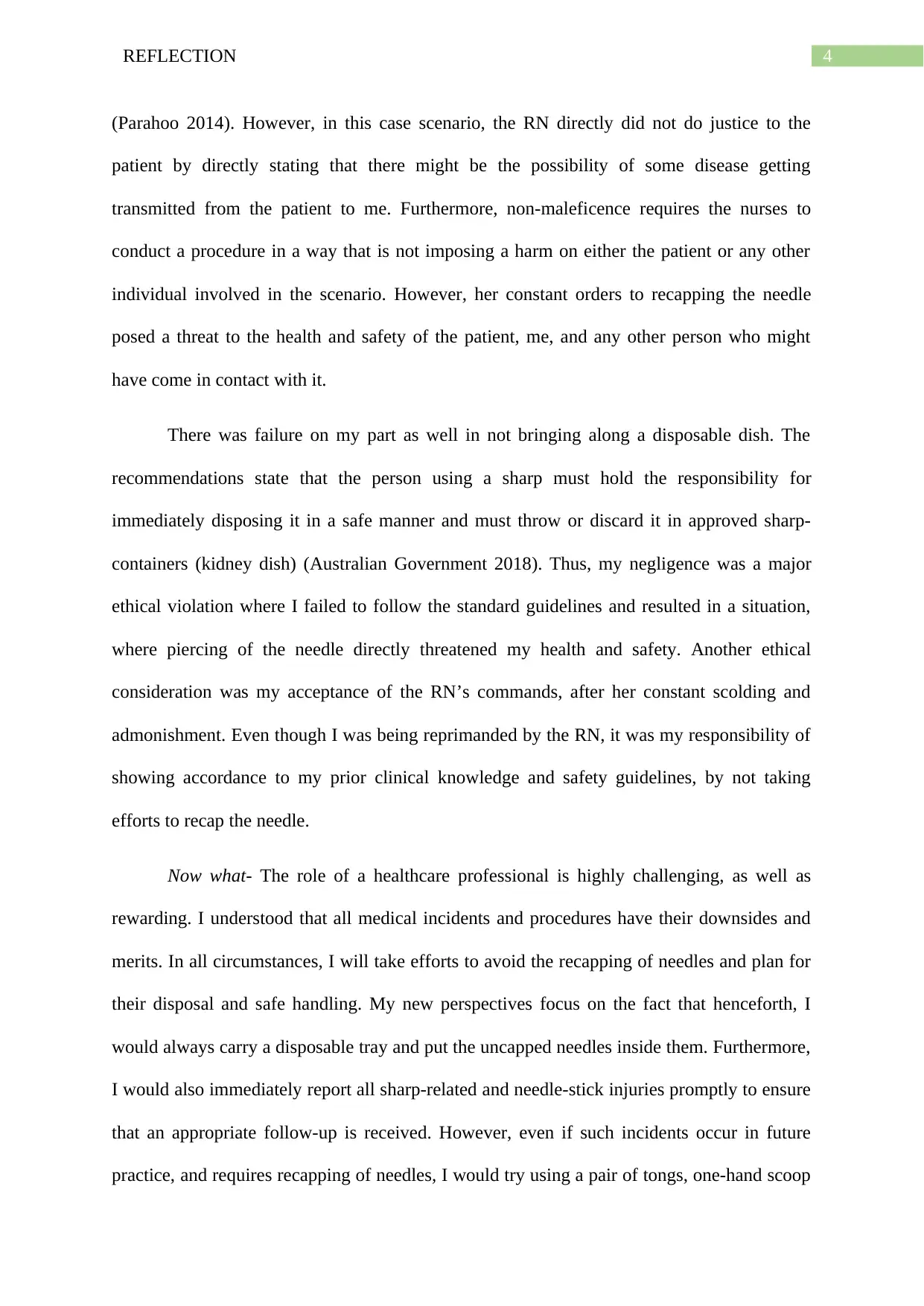
4REFLECTION
(Parahoo 2014). However, in this case scenario, the RN directly did not do justice to the
patient by directly stating that there might be the possibility of some disease getting
transmitted from the patient to me. Furthermore, non-maleficence requires the nurses to
conduct a procedure in a way that is not imposing a harm on either the patient or any other
individual involved in the scenario. However, her constant orders to recapping the needle
posed a threat to the health and safety of the patient, me, and any other person who might
have come in contact with it.
There was failure on my part as well in not bringing along a disposable dish. The
recommendations state that the person using a sharp must hold the responsibility for
immediately disposing it in a safe manner and must throw or discard it in approved sharp-
containers (kidney dish) (Australian Government 2018). Thus, my negligence was a major
ethical violation where I failed to follow the standard guidelines and resulted in a situation,
where piercing of the needle directly threatened my health and safety. Another ethical
consideration was my acceptance of the RN’s commands, after her constant scolding and
admonishment. Even though I was being reprimanded by the RN, it was my responsibility of
showing accordance to my prior clinical knowledge and safety guidelines, by not taking
efforts to recap the needle.
Now what- The role of a healthcare professional is highly challenging, as well as
rewarding. I understood that all medical incidents and procedures have their downsides and
merits. In all circumstances, I will take efforts to avoid the recapping of needles and plan for
their disposal and safe handling. My new perspectives focus on the fact that henceforth, I
would always carry a disposable tray and put the uncapped needles inside them. Furthermore,
I would also immediately report all sharp-related and needle-stick injuries promptly to ensure
that an appropriate follow-up is received. However, even if such incidents occur in future
practice, and requires recapping of needles, I would try using a pair of tongs, one-hand scoop
(Parahoo 2014). However, in this case scenario, the RN directly did not do justice to the
patient by directly stating that there might be the possibility of some disease getting
transmitted from the patient to me. Furthermore, non-maleficence requires the nurses to
conduct a procedure in a way that is not imposing a harm on either the patient or any other
individual involved in the scenario. However, her constant orders to recapping the needle
posed a threat to the health and safety of the patient, me, and any other person who might
have come in contact with it.
There was failure on my part as well in not bringing along a disposable dish. The
recommendations state that the person using a sharp must hold the responsibility for
immediately disposing it in a safe manner and must throw or discard it in approved sharp-
containers (kidney dish) (Australian Government 2018). Thus, my negligence was a major
ethical violation where I failed to follow the standard guidelines and resulted in a situation,
where piercing of the needle directly threatened my health and safety. Another ethical
consideration was my acceptance of the RN’s commands, after her constant scolding and
admonishment. Even though I was being reprimanded by the RN, it was my responsibility of
showing accordance to my prior clinical knowledge and safety guidelines, by not taking
efforts to recap the needle.
Now what- The role of a healthcare professional is highly challenging, as well as
rewarding. I understood that all medical incidents and procedures have their downsides and
merits. In all circumstances, I will take efforts to avoid the recapping of needles and plan for
their disposal and safe handling. My new perspectives focus on the fact that henceforth, I
would always carry a disposable tray and put the uncapped needles inside them. Furthermore,
I would also immediately report all sharp-related and needle-stick injuries promptly to ensure
that an appropriate follow-up is received. However, even if such incidents occur in future
practice, and requires recapping of needles, I would try using a pair of tongs, one-hand scoop
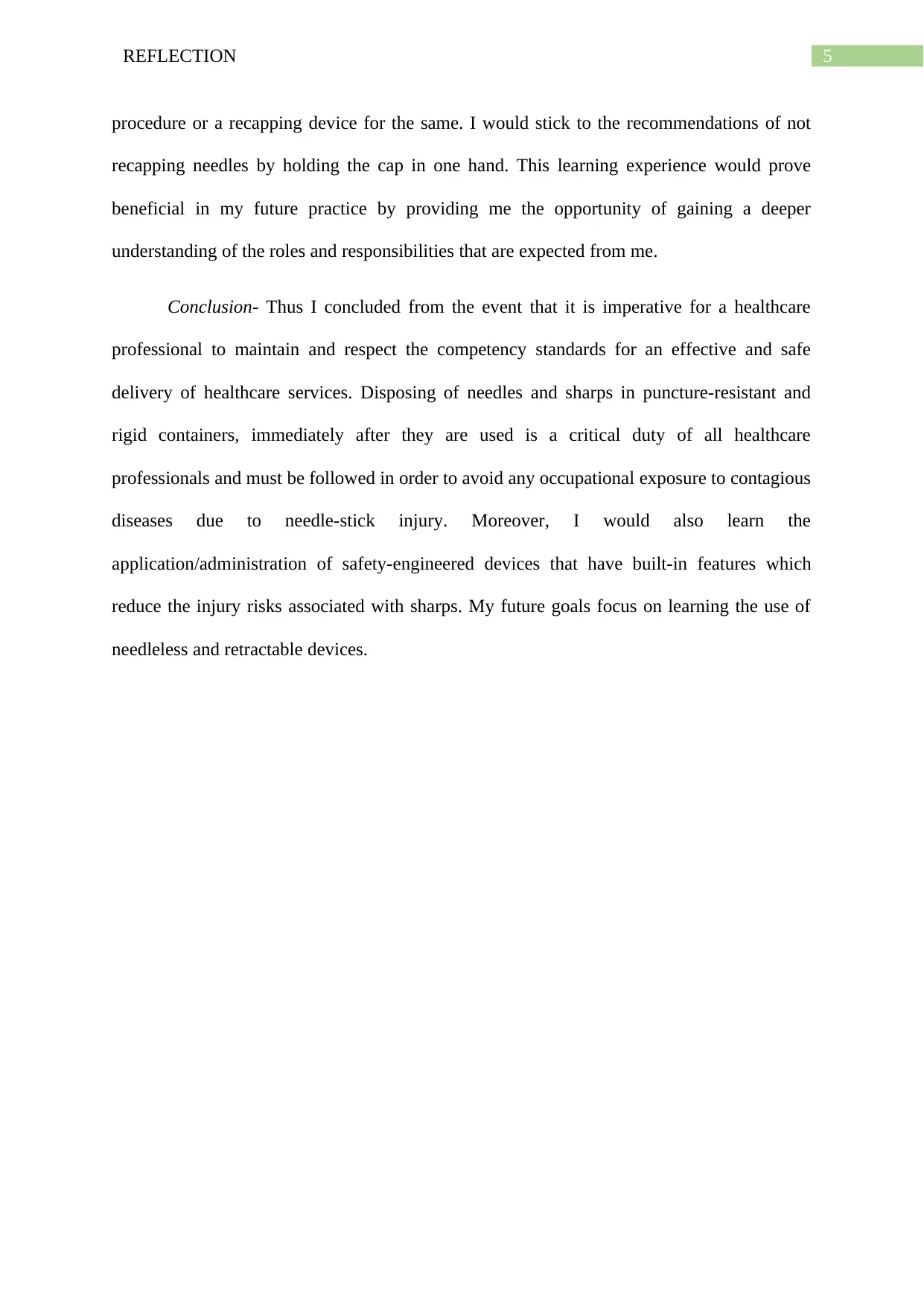
5REFLECTION
procedure or a recapping device for the same. I would stick to the recommendations of not
recapping needles by holding the cap in one hand. This learning experience would prove
beneficial in my future practice by providing me the opportunity of gaining a deeper
understanding of the roles and responsibilities that are expected from me.
Conclusion- Thus I concluded from the event that it is imperative for a healthcare
professional to maintain and respect the competency standards for an effective and safe
delivery of healthcare services. Disposing of needles and sharps in puncture-resistant and
rigid containers, immediately after they are used is a critical duty of all healthcare
professionals and must be followed in order to avoid any occupational exposure to contagious
diseases due to needle-stick injury. Moreover, I would also learn the
application/administration of safety-engineered devices that have built-in features which
reduce the injury risks associated with sharps. My future goals focus on learning the use of
needleless and retractable devices.
procedure or a recapping device for the same. I would stick to the recommendations of not
recapping needles by holding the cap in one hand. This learning experience would prove
beneficial in my future practice by providing me the opportunity of gaining a deeper
understanding of the roles and responsibilities that are expected from me.
Conclusion- Thus I concluded from the event that it is imperative for a healthcare
professional to maintain and respect the competency standards for an effective and safe
delivery of healthcare services. Disposing of needles and sharps in puncture-resistant and
rigid containers, immediately after they are used is a critical duty of all healthcare
professionals and must be followed in order to avoid any occupational exposure to contagious
diseases due to needle-stick injury. Moreover, I would also learn the
application/administration of safety-engineered devices that have built-in features which
reduce the injury risks associated with sharps. My future goals focus on learning the use of
needleless and retractable devices.
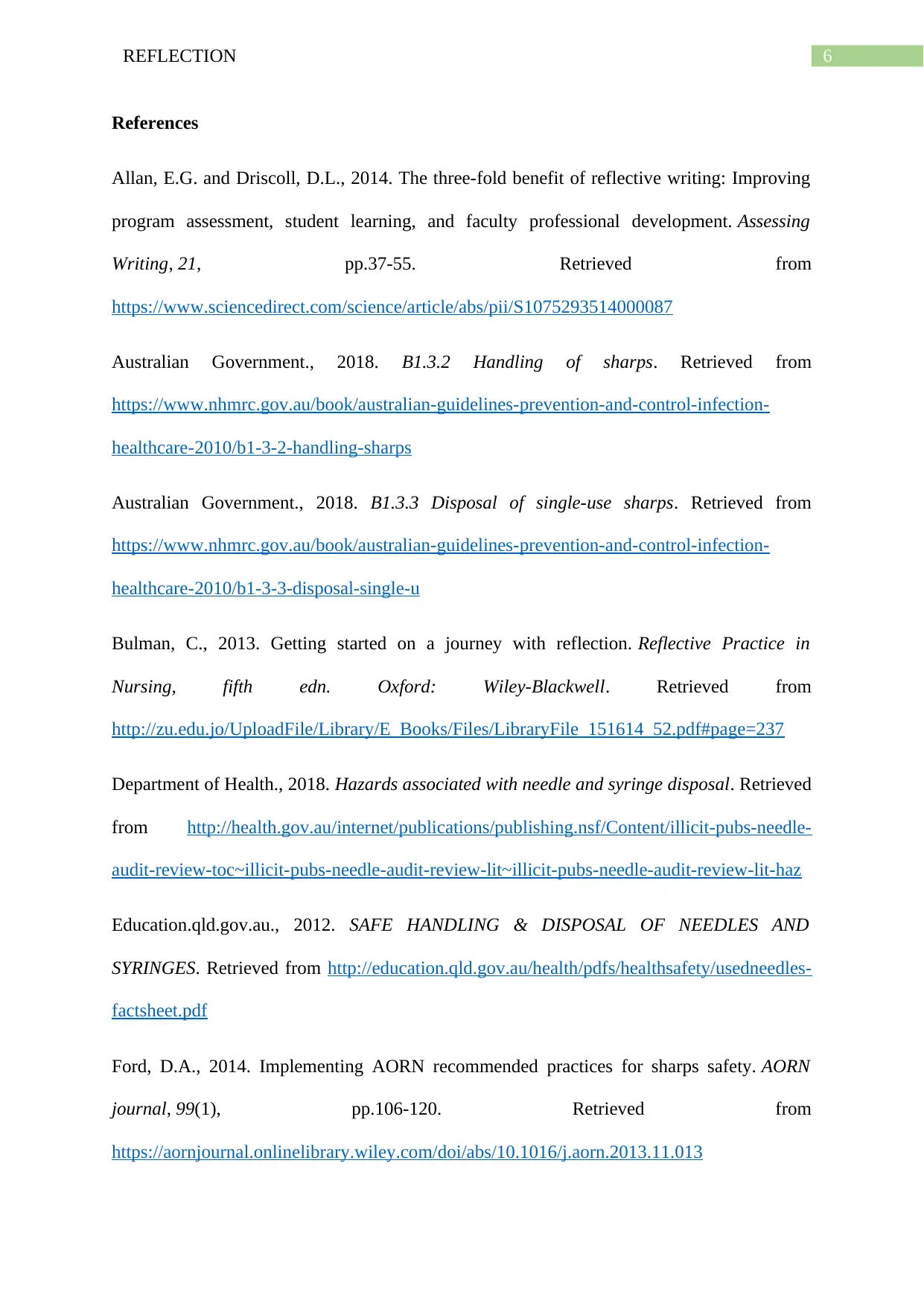
6REFLECTION
References
Allan, E.G. and Driscoll, D.L., 2014. The three-fold benefit of reflective writing: Improving
program assessment, student learning, and faculty professional development. Assessing
Writing, 21, pp.37-55. Retrieved from
https://www.sciencedirect.com/science/article/abs/pii/S1075293514000087
Australian Government., 2018. B1.3.2 Handling of sharps. Retrieved from
https://www.nhmrc.gov.au/book/australian-guidelines-prevention-and-control-infection-
healthcare-2010/b1-3-2-handling-sharps
Australian Government., 2018. B1.3.3 Disposal of single-use sharps. Retrieved from
https://www.nhmrc.gov.au/book/australian-guidelines-prevention-and-control-infection-
healthcare-2010/b1-3-3-disposal-single-u
Bulman, C., 2013. Getting started on a journey with reflection. Reflective Practice in
Nursing, fifth edn. Oxford: Wiley-Blackwell. Retrieved from
http://zu.edu.jo/UploadFile/Library/E_Books/Files/LibraryFile_151614_52.pdf#page=237
Department of Health., 2018. Hazards associated with needle and syringe disposal. Retrieved
from http://health.gov.au/internet/publications/publishing.nsf/Content/illicit-pubs-needle-
audit-review-toc~illicit-pubs-needle-audit-review-lit~illicit-pubs-needle-audit-review-lit-haz
Education.qld.gov.au., 2012. SAFE HANDLING & DISPOSAL OF NEEDLES AND
SYRINGES. Retrieved from http://education.qld.gov.au/health/pdfs/healthsafety/usedneedles-
factsheet.pdf
Ford, D.A., 2014. Implementing AORN recommended practices for sharps safety. AORN
journal, 99(1), pp.106-120. Retrieved from
https://aornjournal.onlinelibrary.wiley.com/doi/abs/10.1016/j.aorn.2013.11.013
References
Allan, E.G. and Driscoll, D.L., 2014. The three-fold benefit of reflective writing: Improving
program assessment, student learning, and faculty professional development. Assessing
Writing, 21, pp.37-55. Retrieved from
https://www.sciencedirect.com/science/article/abs/pii/S1075293514000087
Australian Government., 2018. B1.3.2 Handling of sharps. Retrieved from
https://www.nhmrc.gov.au/book/australian-guidelines-prevention-and-control-infection-
healthcare-2010/b1-3-2-handling-sharps
Australian Government., 2018. B1.3.3 Disposal of single-use sharps. Retrieved from
https://www.nhmrc.gov.au/book/australian-guidelines-prevention-and-control-infection-
healthcare-2010/b1-3-3-disposal-single-u
Bulman, C., 2013. Getting started on a journey with reflection. Reflective Practice in
Nursing, fifth edn. Oxford: Wiley-Blackwell. Retrieved from
http://zu.edu.jo/UploadFile/Library/E_Books/Files/LibraryFile_151614_52.pdf#page=237
Department of Health., 2018. Hazards associated with needle and syringe disposal. Retrieved
from http://health.gov.au/internet/publications/publishing.nsf/Content/illicit-pubs-needle-
audit-review-toc~illicit-pubs-needle-audit-review-lit~illicit-pubs-needle-audit-review-lit-haz
Education.qld.gov.au., 2012. SAFE HANDLING & DISPOSAL OF NEEDLES AND
SYRINGES. Retrieved from http://education.qld.gov.au/health/pdfs/healthsafety/usedneedles-
factsheet.pdf
Ford, D.A., 2014. Implementing AORN recommended practices for sharps safety. AORN
journal, 99(1), pp.106-120. Retrieved from
https://aornjournal.onlinelibrary.wiley.com/doi/abs/10.1016/j.aorn.2013.11.013
Paraphrase This Document
Need a fresh take? Get an instant paraphrase of this document with our AI Paraphraser
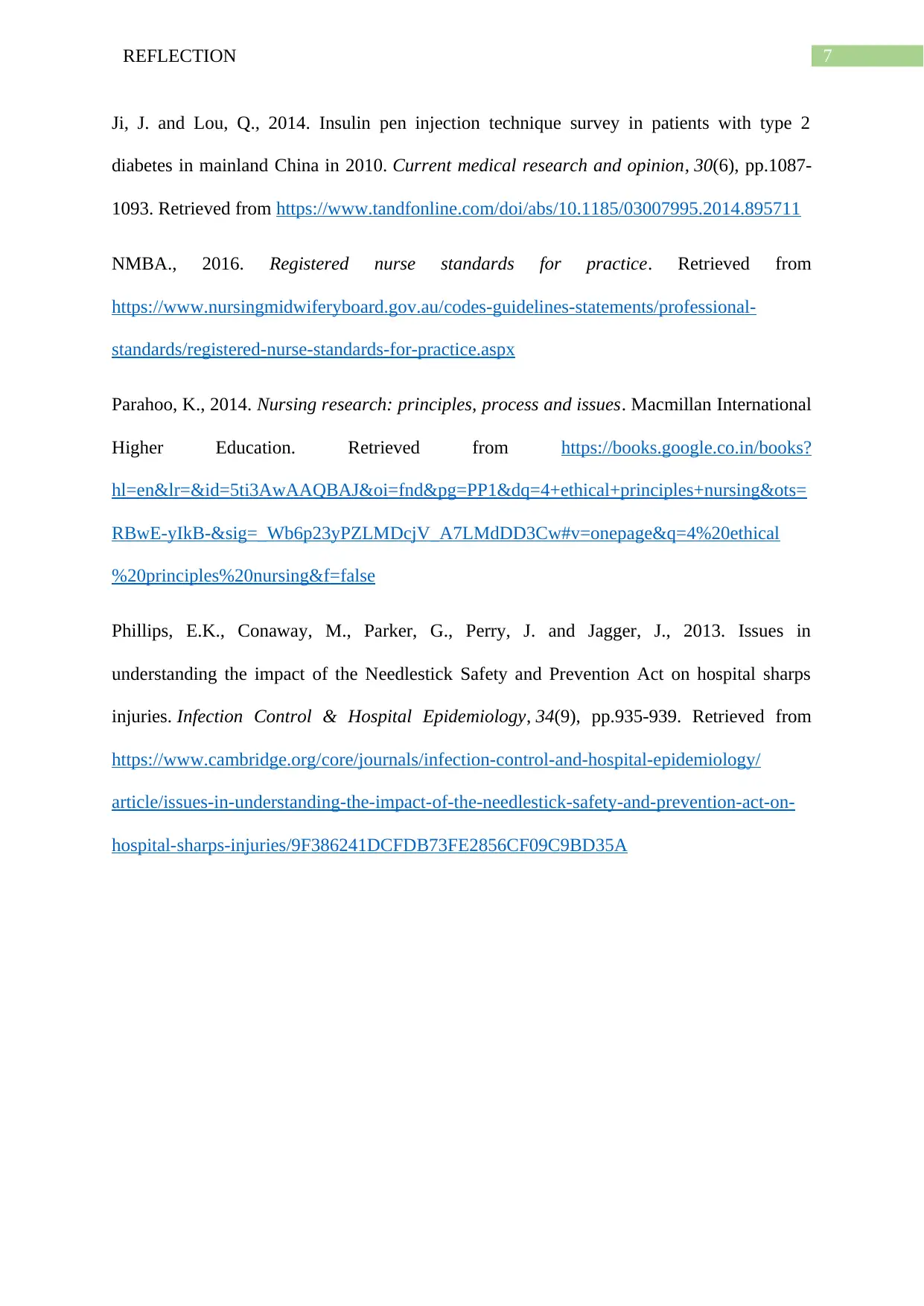
7REFLECTION
Ji, J. and Lou, Q., 2014. Insulin pen injection technique survey in patients with type 2
diabetes in mainland China in 2010. Current medical research and opinion, 30(6), pp.1087-
1093. Retrieved from https://www.tandfonline.com/doi/abs/10.1185/03007995.2014.895711
NMBA., 2016. Registered nurse standards for practice. Retrieved from
https://www.nursingmidwiferyboard.gov.au/codes-guidelines-statements/professional-
standards/registered-nurse-standards-for-practice.aspx
Parahoo, K., 2014. Nursing research: principles, process and issues. Macmillan International
Higher Education. Retrieved from https://books.google.co.in/books?
hl=en&lr=&id=5ti3AwAAQBAJ&oi=fnd&pg=PP1&dq=4+ethical+principles+nursing&ots=
RBwE-yIkB-&sig=_Wb6p23yPZLMDcjV_A7LMdDD3Cw#v=onepage&q=4%20ethical
%20principles%20nursing&f=false
Phillips, E.K., Conaway, M., Parker, G., Perry, J. and Jagger, J., 2013. Issues in
understanding the impact of the Needlestick Safety and Prevention Act on hospital sharps
injuries. Infection Control & Hospital Epidemiology, 34(9), pp.935-939. Retrieved from
https://www.cambridge.org/core/journals/infection-control-and-hospital-epidemiology/
article/issues-in-understanding-the-impact-of-the-needlestick-safety-and-prevention-act-on-
hospital-sharps-injuries/9F386241DCFDB73FE2856CF09C9BD35A
Ji, J. and Lou, Q., 2014. Insulin pen injection technique survey in patients with type 2
diabetes in mainland China in 2010. Current medical research and opinion, 30(6), pp.1087-
1093. Retrieved from https://www.tandfonline.com/doi/abs/10.1185/03007995.2014.895711
NMBA., 2016. Registered nurse standards for practice. Retrieved from
https://www.nursingmidwiferyboard.gov.au/codes-guidelines-statements/professional-
standards/registered-nurse-standards-for-practice.aspx
Parahoo, K., 2014. Nursing research: principles, process and issues. Macmillan International
Higher Education. Retrieved from https://books.google.co.in/books?
hl=en&lr=&id=5ti3AwAAQBAJ&oi=fnd&pg=PP1&dq=4+ethical+principles+nursing&ots=
RBwE-yIkB-&sig=_Wb6p23yPZLMDcjV_A7LMdDD3Cw#v=onepage&q=4%20ethical
%20principles%20nursing&f=false
Phillips, E.K., Conaway, M., Parker, G., Perry, J. and Jagger, J., 2013. Issues in
understanding the impact of the Needlestick Safety and Prevention Act on hospital sharps
injuries. Infection Control & Hospital Epidemiology, 34(9), pp.935-939. Retrieved from
https://www.cambridge.org/core/journals/infection-control-and-hospital-epidemiology/
article/issues-in-understanding-the-impact-of-the-needlestick-safety-and-prevention-act-on-
hospital-sharps-injuries/9F386241DCFDB73FE2856CF09C9BD35A
1 out of 8
Related Documents
Your All-in-One AI-Powered Toolkit for Academic Success.
+13062052269
info@desklib.com
Available 24*7 on WhatsApp / Email
![[object Object]](/_next/static/media/star-bottom.7253800d.svg)
Unlock your academic potential
© 2024 | Zucol Services PVT LTD | All rights reserved.





